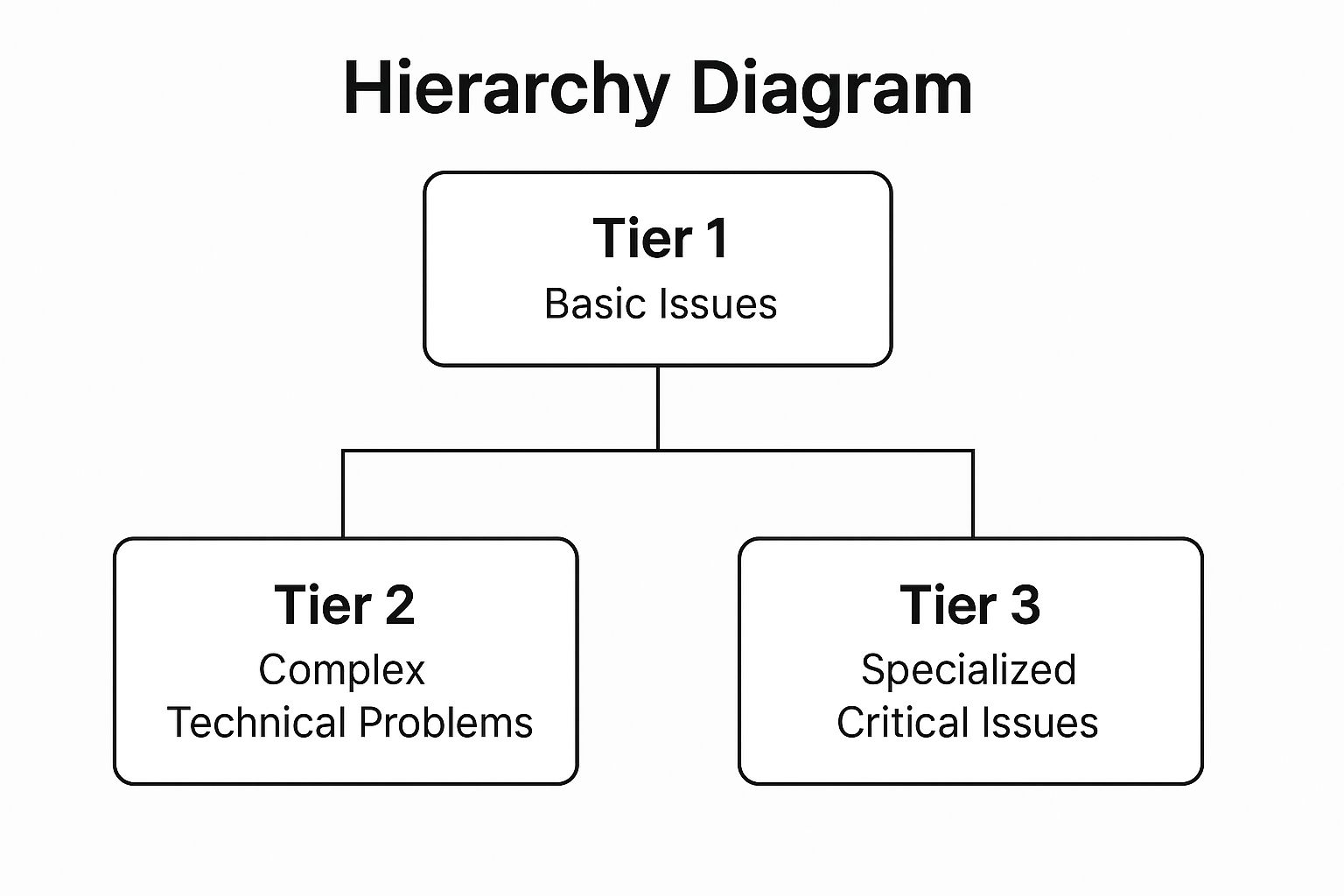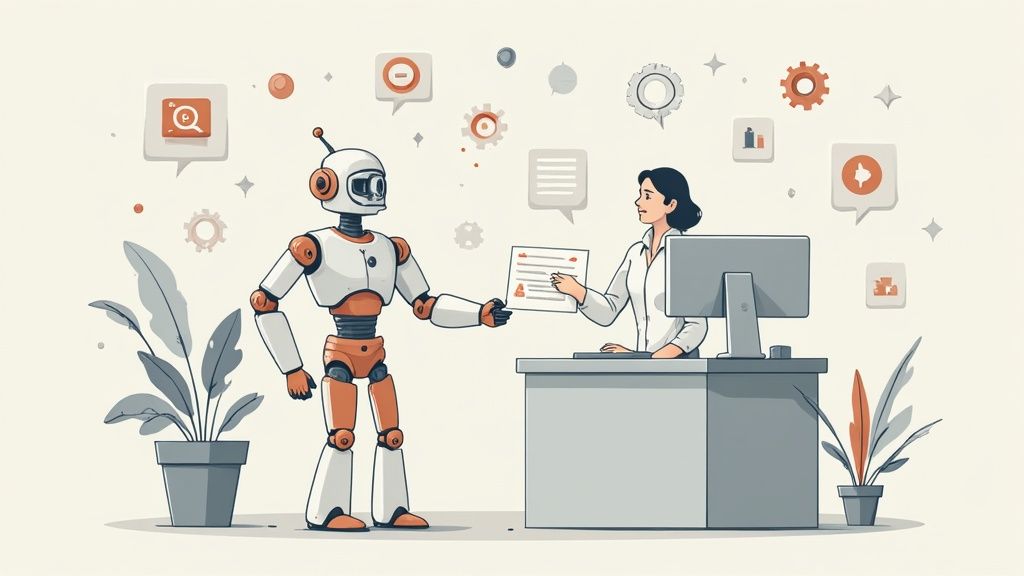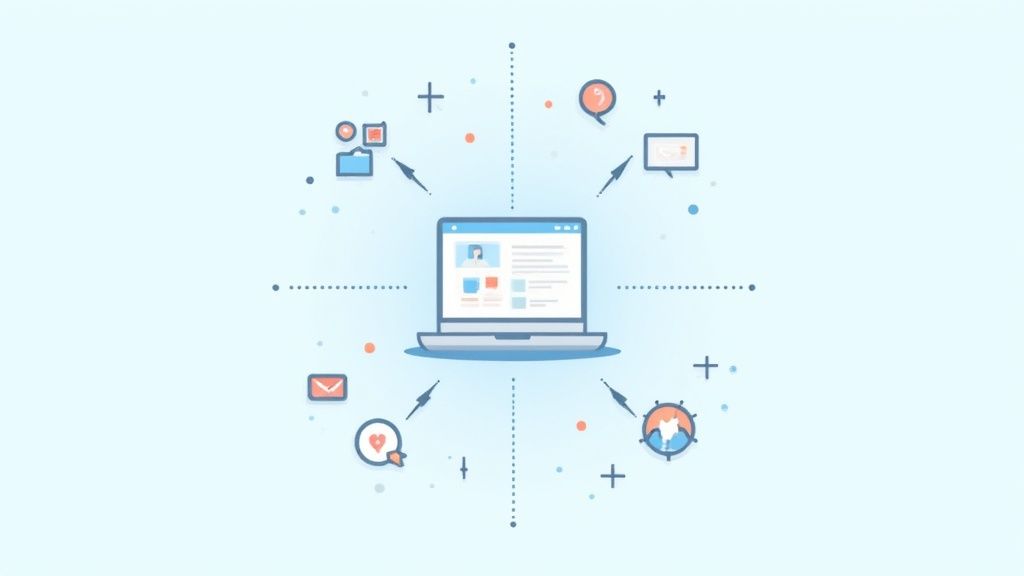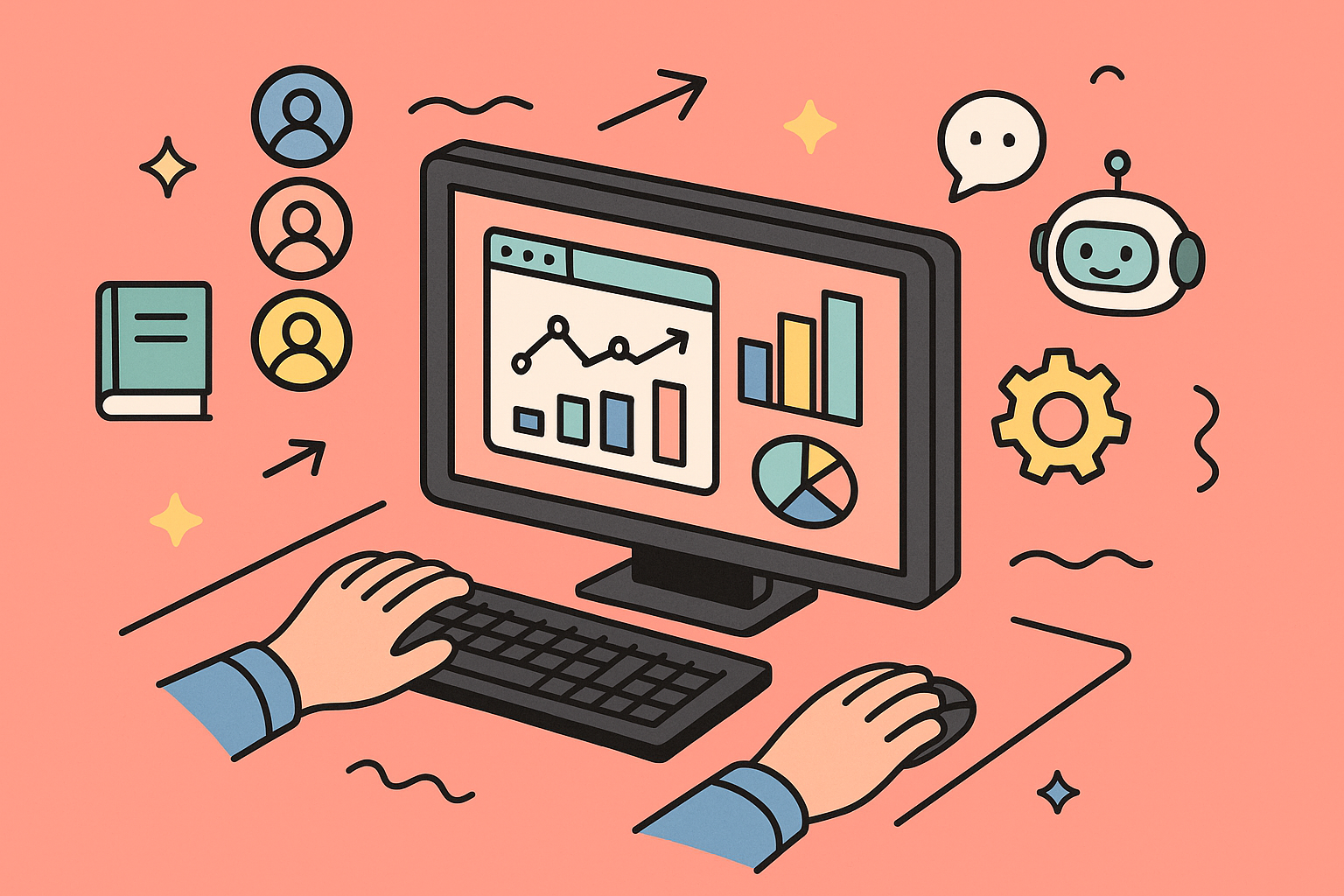In today’s fast-paced business environment, a reactive help desk is a liability. Customers and internal teams alike expect fast, accurate, and seamless support to resolve issues and maintain productivity. Simply answering tickets as they arrive is no longer a viable strategy for success. The key lies in building a proactive, data-driven, and resilient support ecosystem that anticipates needs and operates efficiently. But where do you begin the transformation from a simple ticketing system to a strategic asset?
This guide cuts through the noise to deliver seven actionable help desk best practices that drive tangible results. We’ll move beyond generic advice and provide a clear roadmap for implementation. You will learn how to structure your support with tiers, build a comprehensive knowledge base, and define the KPIs that truly matter. For those looking for even more foundational strategies, exploring these 8 Best Practices for Help Desk Success can provide additional valuable context.
Crucially, we’ll demonstrate how to leverage powerful automation to enhance these practices. A key focus will be on maintaining service continuity, even when key personnel are away, by integrating out-of-office automation directly within Jira Cloud. Get ready to learn how to deliver exceptional service without interruption.
1. Implement a Tiered Support Structure
One of the most foundational help desk best practices is to organize support into a tiered structure. This model segments agents into different levels, or tiers, based on their technical expertise and the complexity of the issues they handle. This approach prevents overwhelming senior engineers with basic, repetitive questions and ensures that tickets are routed to the person best equipped to solve them efficiently.
A tiered system typically starts with Tier 1, the first point of contact for all incoming requests. These agents handle common, straightforward issues like password resets or basic software navigation. If a problem is too complex, it’s escalated to Tier 2, which consists of agents with deeper technical knowledge who can tackle more intricate software or hardware problems. Finally, highly specialized or critical issues, such as bugs requiring code changes or major system outages, are escalated to Tier 3, which often includes senior engineers or product developers.
How a Tiered Structure Drives Efficiency
This structured escalation path ensures that resources are allocated effectively. It allows Tier 1 agents to resolve a high volume of simple tickets quickly, improving first-contact resolution rates and overall customer satisfaction. Meanwhile, it protects the valuable time of senior specialists in Tiers 2 and 3, allowing them to focus on the complex challenges that require their specific expertise. Major enterprise companies like Microsoft and Salesforce have long used this model to manage their vast support operations, proving its scalability and effectiveness.
The following infographic illustrates the typical flow of support requests through this hierarchical model.

This visualization highlights how a structured hierarchy filters issues by complexity, ensuring efficient problem-solving at the appropriate level.
Actionable Tips for Implementation
To successfully implement a tiered support structure, consider these practical steps:
- Define Clear Escalation Triggers: Document precise criteria for when a ticket should be moved from one tier to the next. For example, a ticket is escalated from Tier 1 if it remains unresolved for more than 60 minutes or requires administrator-level access.
- Establish Seamless Handoffs: Use standardized templates in your Jira issues to ensure all necessary diagnostic information, troubleshooting steps already taken, and user communications are passed between tiers. This prevents agents from asking redundant questions.
- Promote Inter-Tier Knowledge Sharing: Schedule regular meetings where Tier 2 and 3 agents can train Tier 1 staff on resolving newly common issues. This “shift-left” approach empowers frontline agents and reduces escalations over time.
2. Establish Comprehensive Knowledge Management
Another core component of high-performing help desk best practices is establishing a comprehensive knowledge management system. This system acts as a single source of truth for all support-related information, housing everything from step-by-step troubleshooting guides and product documentation to historical ticket resolutions and FAQs. By centralizing this intelligence, you empower agents to deliver consistent, accurate answers and enable customers to find solutions independently.
A robust knowledge base is the backbone of an efficient support operation. When an agent receives a query, their first action should be to consult the knowledge base. This repository provides pre-approved, standardized solutions, which drastically reduces resolution times and ensures every customer receives the same high-quality information. Leading platforms like Atlassian’s Confluence and Zendesk’s Guide have built their success on providing powerful tools for creating and managing these essential information hubs.
How Knowledge Management Drives Consistency
A well-maintained knowledge base ensures that institutional knowledge doesn’t walk out the door when an experienced agent leaves. It democratizes information, allowing new hires to get up to speed quickly and Tier 1 agents to confidently resolve a wider range of issues without escalation. This practice directly improves key metrics like first-contact resolution and reduces the average handle time per ticket.
For your help desk to maintain an accurate and reliable knowledge base, implementing robust document control best practices for your knowledge base is essential. This ensures that all information is up-to-date, reviewed, and approved, preventing the spread of outdated or incorrect advice.
Actionable Tips for Implementation
To build a knowledge base that truly empowers your team and customers, follow these steps:
- Implement Content Governance: Define roles and responsibilities for creating, reviewing, and approving content. Create standardized templates in Confluence or your chosen platform to ensure every article has a consistent structure and includes necessary details like version history and author.
- Use Analytics to Identify Knowledge Gaps: Regularly analyze support ticket data and search queries within your knowledge base. If users frequently search for a term but find no relevant articles, that’s a clear signal to create new content on that topic.
- Encourage Agent Contributions: Motivate agents to contribute by making the process easy. Set up a workflow where agents can flag tickets with valuable solutions to be converted into knowledge base articles, or allow them to draft articles directly for review.
- Conduct Regular Content Audits: Schedule quarterly or bi-annual reviews of all existing articles to check for accuracy and relevance. Archive outdated content to keep the knowledge base clean and trustworthy.
You can learn more about building an effective knowledge base on resolution.de.
3. Define and Monitor Key Performance Indicators (KPIs)
You cannot improve what you do not measure, and this principle is a cornerstone of effective help desk best practices. Establishing and monitoring Key Performance Indicators (KPIs) provides objective, data-driven insights into your team’s performance. This allows you to track progress against goals, identify bottlenecks, and ensure you are consistently meeting Service Level Agreements (SLAs).
Commonly tracked metrics include First-Contact Resolution (FCR), which measures how many issues are solved during the initial interaction, and Average Resolution Time (ART), which tracks the total time from ticket creation to resolution. Other crucial indicators are Customer Satisfaction (CSAT) scores and Ticket Volume Trends, which help gauge service quality and forecast staffing needs. To effectively measure your help desk’s success, delve deeper into understanding the most important key help desk metrics that align with your business objectives.
How KPIs Drive Performance
By focusing on specific metrics, you can transform abstract goals like “better customer service” into tangible, measurable outcomes. This data-centric approach helps justify resource allocation, demonstrate the value of your help desk, and guide strategic decisions. For instance, Amazon’s renowned customer service operation relentlessly tracks resolution times and customer effort scores to minimize friction. Similarly, Apple uses the Net Promoter Score (NPS) after support interactions to measure customer loyalty and identify areas for improvement. This shows how top-tier companies leverage KPIs to maintain service excellence.
This commitment to measurement is a core philosophy popularized by frameworks like ITIL and organizations such as HDI (Help Desk Institute), which advocate for data-driven service management. You can learn more about defining the right help desk metrics on Resolution’s blog.
Actionable Tips for Implementation
To effectively integrate KPIs into your help desk operations, follow these steps:
- Balance Efficiency and Quality Metrics: Avoid focusing solely on speed (like average handle time) at the expense of quality. Pair efficiency KPIs with quality metrics like CSAT or FCR to get a holistic view of performance.
- Set Realistic but Challenging Targets: Use historical data in Jira to establish baseline performance, then set achievable yet ambitious goals that encourage continuous improvement without demoralizing your team.
- Use Data for Coaching, Not Punishment: Frame KPI discussions as opportunities for professional development. If an agent’s resolution time is high, use the data to identify potential knowledge gaps and provide targeted training.
- Regularly Review and Adjust KPIs: Business priorities change, and your KPIs should reflect that. Schedule quarterly reviews to ensure your metrics are still aligned with organizational goals and are driving the right behaviors.
4. Provide Comprehensive Agent Training and Development
A highly skilled help desk team is not born; it’s built through continuous and comprehensive training. This critical help desk best practice involves more than a one-time onboarding session. It requires an ongoing commitment to developing agents’ technical knowledge, soft skills, and product expertise to ensure they can consistently deliver exceptional service. A well-trained agent is equipped to handle complex issues with confidence and communicate with empathy, directly impacting customer satisfaction and loyalty.
This approach means creating a robust development program that covers everything from initial product training to advanced troubleshooting techniques and emotional intelligence. Companies renowned for service, like Zappos and Ritz-Carlton, invest heavily in training that extends beyond technical skills. They focus on instilling a deep understanding of company culture and service excellence, empowering agents to act as brand ambassadors.
How Training and Development Boosts Performance
Investing in agent development yields significant returns in both efficiency and service quality. It reduces ticket resolution times, decreases escalations, and improves first-contact resolution rates. When agents are confident in their knowledge, they can diagnose problems faster and provide more accurate solutions. Furthermore, training in soft skills, such as active listening and conflict resolution, transforms challenging customer interactions into positive experiences. This focus on holistic development has been popularized by customer service experts like Ron Kaufman and training organizations such as Dale Carnegie.
Actionable Tips for Implementation
To build a successful training and development program for your help desk, consider these practical steps:
- Focus on Both Technical and Soft Skills: Develop separate training modules for product knowledge and customer interaction skills. Use role-playing scenarios in workshops to practice handling difficult conversations and de-escalating frustrated users.
- Use Diverse Training Formats: Combine different learning methods to keep agents engaged. Use e-learning modules for self-paced technical training, interactive workshops for soft skills, and shadowing senior agents for practical, on-the-job experience.
- Implement a Peer-to-Peer Learning System: Encourage knowledge sharing by creating mentorship programs where experienced agents guide new hires. You can also implement cross-training to build a more versatile and resilient team. Learn more about effective cross-training strategies on resolution.de.
- Schedule Regular Refresher Training: Keep skills sharp by conducting ongoing training sessions, especially when new products, features, or internal processes are introduced. Use skill assessments to identify knowledge gaps that need to be addressed.
5. Leverage Automation and AI Technologies
Another essential help desk best practice is to embrace automation and artificial intelligence (AI). Modern help desks can dramatically improve their efficiency by using technology to handle repetitive, high-volume tasks. This frees human agents to focus on complex, high-value interactions that require empathy, critical thinking, and nuanced problem-solving. Automation can manage everything from ticket categorization and routing to providing instant answers via chatbots.
AI-powered systems go a step further by learning from historical data to offer predictive support and suggest solutions to agents in real time. This technological layer not only speeds up resolution times but also creates a more consistent and scalable support experience. By automating routine workflows, you can ensure that processes are followed correctly every time, reducing human error and boosting overall productivity.

How Automation and AI Drive Efficiency
By integrating AI, help desks can offer 24/7 support through chatbots that handle common queries like order status or account information, significantly reducing ticket volume. For instance, platforms like Salesforce Einstein AI automatically classify incoming cases and route them to the correct agent queue, eliminating manual triage. Similarly, Freshworks’ Freddy AI can analyze user sentiment and prioritize urgent issues, ensuring critical problems get immediate attention. This smart allocation of resources is a core advantage of process automation. You can explore the benefits in more detail and learn more about process automation on resolution.de. This allows human agents to dedicate their expertise to resolving intricate customer issues that automation cannot handle.
Actionable Tips for Implementation
To effectively integrate automation and AI into your help desk, follow these practical steps:
- Start with Simple, Rule-Based Automation: Begin by automating straightforward, high-frequency tasks. For example, create an automation rule in Jira Service Management that automatically closes a ticket if a customer hasn’t responded to a request for information after 72 hours.
- Maintain Human Oversight: Always design automated systems with a human in the loop. Ensure that AI-driven responses are monitored for quality and accuracy, and create a clear escalation path for when a chatbot or automated system fails to resolve an issue.
- Regularly Update AI Training Data: An AI is only as good as the data it learns from. Continuously feed your AI models with new ticket data, knowledge base articles, and successful resolutions to improve their accuracy and relevance over time.
- Provide an Easy “Escape Hatch”: Ensure customers interacting with a chatbot can seamlessly transfer to a human agent at any point in the conversation. This prevents frustration and shows that you value their time.
6. Maintain Proactive Communication and Transparency
A key differentiator between a good help desk and a great one is the shift from reactive to proactive communication. Instead of waiting for users to chase for updates, this help desk best practice involves actively informing them about issue status, planned maintenance, and potential outages. This transparency builds immense trust, manages user expectations effectively, and significantly reduces the volume of follow-up inquiries, freeing up agents to focus on problem-solving.
This approach is about keeping stakeholders in the loop before they even think to ask. When a system-wide issue occurs, proactive updates prevent a flood of duplicate tickets reporting the same problem. Leading tech companies with high-availability services have perfected this model. For instance, Atlassian’s status page provides real-time updates on service disruptions, while Amazon Web Services (AWS) offers detailed post-incident reports that build user confidence even after a problem.
How Proactive Communication Builds Trust
By communicating openly and regularly, you demonstrate a commitment to your users’ success and respect for their time. It transforms the help desk from a mere problem-fixing unit into a reliable partner. This transparency is particularly crucial during widespread incidents, as it reassures users that you are aware of the issue and actively working on a resolution. It also helps manage expectations by providing realistic timelines, preventing user frustration from boiling over.
Actionable Tips for Implementation
To build a culture of proactive communication, consider these practical steps:
- Establish a Centralized Status Page: Use a tool to create a public or internal status page where you can post real-time updates on system health and incidents. This becomes the single source of truth for users.
- Utilize Pre-Written Templates: Prepare communication templates in your Jira or ITSM tool for common scenarios like system degradation, unplanned outages, or scheduled maintenance. This ensures messages are consistent, clear, and can be deployed quickly.
- Leverage Multiple Channels: Don’t rely on a single communication method. Use a combination of email, in-app notifications, and a dedicated status portal to ensure your message reaches the widest possible audience. A well-defined stakeholder communication plan is essential for this. Learn more about creating a stakeholder communication plan on resolution.de.
7. Implement an Omnichannel Support Strategy
Adopting an omnichannel support strategy is a critical help desk best practice that moves beyond simply offering multiple communication channels. It focuses on creating a unified, seamless experience where conversation history and context are maintained as users switch between platforms like email, live chat, phone, and social media. This integration ensures customers never have to repeat themselves, providing a consistent and frictionless support journey.
An omnichannel approach means a customer can start a conversation on a web chat, continue it over email, and reference it during a phone call without any loss of information. The agent handling the ticket has a complete, chronological view of all previous interactions, regardless of the channel used. This holistic perspective is fundamental to delivering modern, customer-centric service.

How an Omnichannel Strategy Elevates Customer Experience
This unified model directly improves customer satisfaction by respecting their time and effort. It empowers them to use their preferred channel at any given moment without penalty. Companies renowned for their customer experience, such as Starbucks and Bank of America, have perfected this by integrating their mobile app, web, and in-person services. A customer can start an order on their phone and complete it in-store, with all data synchronized seamlessly. In a help desk context, this means less frustration and faster resolutions.
This strategy centralizes customer data, providing valuable insights into user behavior and channel preferences. By analyzing how users move between channels, you can optimize your support offerings and allocate resources more effectively.
Actionable Tips for Implementation
To build a successful omnichannel support system, follow these practical steps:
- Integrate Key Channels First: Start by integrating your most popular channels, such as email and a self-service portal within Jira Service Management. Gradually expand to other platforms like chat or phone systems as you perfect the synchronization.
- Ensure Data Synchronization: Use a central help desk platform that can aggregate conversations from all channels into a single, unified customer ticket or profile. Ensure that updates from one channel are instantly visible on all others.
- Train Agents for Versatility: Equip your support agents with the skills and tools to manage interactions across multiple channels. Consistent training ensures the tone and quality of support remain high, regardless of the platform.
- Maintain a Consistent Brand Voice: Develop clear guidelines for communication to ensure your help desk’s branding and tone are consistent across all channels, reinforcing a professional and unified presence.
Best Practices Comparison of 7 Help Desk Strategies
| Strategy | Implementation Complexity 🔄 | Resource Requirements ⚡ | Expected Outcomes 📊 | Ideal Use Cases 💡 | Key Advantages ⭐ |
|---|---|---|---|---|---|
| Implement a Tiered Support Structure | Medium to High (multi-tier setup, training) | Moderate (specialized staff at each tier) | Faster resolution, better resource utilization | Organizations with varied issue complexity and staff specialization | Improved first-call resolution, clear escalation paths |
| Establish Comprehensive Knowledge Management | Medium (content creation & maintenance) | High (initial knowledge base build, ongoing updates) | Consistent info, reduced resolution time | Teams needing centralized, searchable support resources | Enhanced self-service, improved agent productivity |
| Define and Monitor Key Performance Indicators (KPIs) | Medium (dashboard & metric setup) | Moderate (data collection and analysis tools) | Data-driven decisions, accountability | Support teams focused on performance monitoring | Clear visibility, improved planning |
| Provide Comprehensive Agent Training and Development | High (ongoing training and coaching) | High (time, cost, and coordination) | Better service quality and retention | Organizations investing in long-term employee growth | Higher satisfaction, reduced escalations |
| Leverage Automation and AI Technologies | High (tech integration and AI tuning) | High (software, maintenance, training) | Faster response, 24/7 coverage | Enterprises aiming to automate routine support tasks | Cost reduction, consistent service delivery |
| Maintain Proactive Communication and Transparency | Low to Medium (automation & coordination) | Moderate (communication tools and staff effort) | Increased trust, fewer inquiries | High-availability or incident-prone environments | Stronger customer trust, reduced frustration |
| Implement Omnichannel Support Strategy | High (complex integration across channels) | High (tech infrastructure, multi-channel training) | Seamless cross-channel support | Businesses with diverse customer contact preferences | Enhanced convenience, improved loyalty |
Transforming Your Help Desk into a Proactive Powerhouse
Navigating the landscape of modern customer support requires more than just answering tickets; it demands a strategic, forward-thinking approach. The journey from a reactive support desk to a proactive value-driver is built upon the foundational principles we’ve explored. Mastering these help desk best practices isn’t just about incremental improvements, it’s about engineering a system that anticipates needs, empowers users, and operates with seamless efficiency.
By implementing a tiered support structure and a robust knowledge management system, you create clear pathways for issue resolution and self-service. These elements work in tandem, reducing agent workload and providing users with immediate answers. Simultaneously, defining and meticulously tracking Key Performance Indicators (KPIs) provides the data-driven clarity needed to identify bottlenecks, celebrate successes, and justify investments in your support operations.
From Foundation to Innovation
A strong foundation is critical, but true excellence is achieved when you build upon it with strategic innovation. This is where comprehensive agent training and an omnichannel support strategy come into play, ensuring your team is skilled, confident, and accessible wherever your customers are. Maintaining proactive communication transforms your help desk from a mere problem-solver into a trusted partner, building loyalty and reducing inbound ticket volume by keeping users informed.
However, the most significant leap forward comes from intelligently leveraging technology. Automation is no longer a luxury; it is the engine of a modern, resilient help desk. By automating routine tasks and workflows, you free your highly skilled agents to focus on complex, high-value interactions that require a human touch.
Key Takeaway: The ultimate goal is to create a self-reinforcing cycle of improvement. A well-trained team, supported by a rich knowledge base and smart automation, delivers better service. This leads to higher customer satisfaction, which in turn boosts team morale and provides the data needed to further refine your processes.
Your Actionable Next Steps
Adopting all these practices at once can feel overwhelming. Instead, focus on a phased implementation:
- Assess Your Current State: Start by auditing your existing processes. Where are the most significant pain points? Are tickets lingering due to agent absences? Is your knowledge base outdated?
- Prioritize One or Two Practices: Select the practice that will deliver the most immediate impact. If SLA breaches during holidays are a major issue, focus on automation first. If agent burnout is high, prioritize knowledge management and tiered support.
- Implement and Measure: Roll out your chosen practice and track its effect on your core KPIs. Use this data to demonstrate value and build momentum for the next initiative. For instance, implementing an out-of-office automation solution should directly correlate with improved response times and SLA compliance.
By systematically applying these help desk best practices, you will not only enhance customer satisfaction but also create a more sustainable, efficient, and rewarding environment for your support team. You will transform your help desk from a cost center into a strategic asset that actively contributes to business growth and customer retention.
Ready to bulletproof your support continuity and empower your team? Discover how resolution Reichert Network Solutions GmbH can automate your out-of-office workflows in Jira Cloud, ensuring no ticket is ever left behind. Explore the Out of Office Assistant and take the first step toward a truly resilient help desk.
